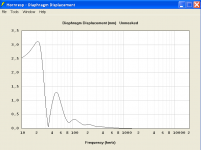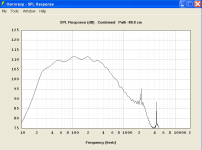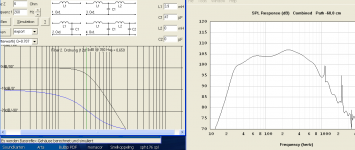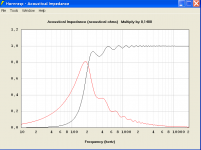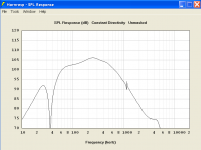you can search for free cardboard and try to make a cardboard recktangular horn to se if you can solve that and it cost nothing only time.
When you managed that you can make with that mold a triplex horn, the bas-reflex enclosure shout be easy after that.
The cardboard horn can be use for measurements. You could make glass-fiber on it and make a glass-fiber front horn that way.
When you managed that you can make with that mold a triplex horn, the bas-reflex enclosure shout be easy after that.
The cardboard horn can be use for measurements. You could make glass-fiber on it and make a glass-fiber front horn that way.
nice pictures Helmuth, thanks
but how do you manage to get a 'woofer' with 55hz/Fs to go that low, and with only 2.5mm Xmax ?
maybe take a look at the new SPA-12PA
http://monacor.co.uk/products/speakerbuilding-pa10-12/vnr/105280/
but could be that Qts is too high
ther's also a new SPA-10PA
I have the 15", and I dont know why the smaller ones aren't shown in your German Monaco cataloge
but how do you manage to get a 'woofer' with 55hz/Fs to go that low, and with only 2.5mm Xmax ?
maybe take a look at the new SPA-12PA
http://monacor.co.uk/products/speakerbuilding-pa10-12/vnr/105280/
but could be that Qts is too high
ther's also a new SPA-10PA
I have the 15", and I dont know why the smaller ones aren't shown in your German Monaco cataloge
but how do you manage to get a 'woofer' with 55hz/Fs to go that low, and with only 2.5mm Xmax ?
Hi Tinitus,
you're making a think fault. This sp12/100pa is the ideal woofer for single ended tube amplifiers.
The think fault you are making is thinking the 2,5mm with 12" and 25Hz isn't enough.
I will explain (extrusion) * (surface Sd) = Soundpressure.
This woofer is a perfect match with single ended tube stages up to 10W. It will operate then up to its limit. See pictures xmax at 25hz with 3.1W and a amazing soundpresuure of 110dB 1mtr.
this design is a perfect match for single ended:
2A3 SE 2W (4W in PSE)
300B SE 5w (10W in PSE)
GM70/845/813 it will also do 15-25w then it would be smart to make a second order cut off at 30Hz.
With music it is not very likely that maximum power is only at the frequency where x-max is. this woofer will do good with 10Watt music and can theoretically kick x-max sometimes without damage.
It is a non-issue I have a small 4 inch in a monitor that does 30Hz only 85 dB even with that I can listen loud in a normal living room.
With 110dB and that low you will blow away the neighbors it is very very loud it is a lovely 12" the sp12/100pa.
The xmax is the same for the Revintage design
Attachments
Last edited:
Hey Helmuth,
Go for 1,0xPi instead, when designing. It will be next to impossible/unrealistic to get a perfect corner-placement.
EQ will off course help.
The one I did on your "theme" was just for showing what happened when going another route.
When you go 1,0, you will get shelving, which can be helped by a smaller box. The penalty is higher Fl.
Also you will probably also need a 2-300Hz midhorn.
Go for 1,0xPi instead, when designing. It will be next to impossible/unrealistic to get a perfect corner-placement.
EQ will off course help.
The one I did on your "theme" was just for showing what happened when going another route.
When you go 1,0, you will get shelving, which can be helped by a smaller box. The penalty is higher Fl.
Also you will probably also need a 2-300Hz midhorn.
Thats true here a optimized simulation 1phi.Hey Helmuth,
Go for 1,0xPi instead, when designing. It will be next to impossible/unrealistic to get a perfect corner-placement.
EQ will off course help.
The one I did on your "theme" was just for showing what happened when going another route.
When you go 1,0, you will get shelving, which can be helped by a smaller box. The penalty is higher Fl.
With the low pass filter it will be flat 1phi 40 to 400Hz and 30Hz -4dB still very good value's. I think with a resistance in series with the filter capacitor will stretch high response to 500Hz. that is with a single ended power a reasonable value to cut off with a big mid high horn.
Also you will probably also need a 2-300Hz midhorn.
I do not understand what you mean.
Attachments
Last edited:
Hey Helmuth,
Also you will probably also need a 2-300Hz midhorn.
I understand 2" 300Hz cutoff midhorn 🙂
To call this 30Hz -4dB is far to optimistic. But with the help of EQ(active or passive) it might work.
If you want to check frequency response you must use Directivity with your intended listening angle. Unfortunately one cannot use Directivity at the same time as Combined. So you have to do some adding by yourself.
About midhorn:
OK, if you crossover at let´s say 400Hz, you will need a midrange horn designed for, in the ballpark of, 200-250Hz.
If you want to check frequency response you must use Directivity with your intended listening angle. Unfortunately one cannot use Directivity at the same time as Combined. So you have to do some adding by yourself.
About midhorn:
OK, if you crossover at let´s say 400Hz, you will need a midrange horn designed for, in the ballpark of, 200-250Hz.
with some passive cross over tricks the response can be stretched up to 500Hz to get a XO point where some 2" drivers still will work properly.To call this 30Hz -4dB is far to optimistic. But with the help of EQ(active or passive) it might work.
If you want to check frequency response you must use Directivity with your intended listening angle. Unfortunately one cannot use Directivity at the same time as Combined. So you have to do some adding by yourself.
About midhorn:
OK, if you crossover at let´s say 400Hz, you will need a midrange horn designed for, in the ballpark of, 200-250Hz.
luckily the sp12/100pa is low cost so we have some money spare for the HF driver
Last edited:
Thats correct. Did a check and a Tractrix with 2" driver for 280Hz can be used down to 500Hz and a 240Hz down to 400Hz. There are quite a few drivers capable of being used well below 400Hz.
Last edited:
Do you know good cheap one's Revintage.Thats correct. Did a check and a Tractrix with 2" driver for 280Hz can be used down to 500Hz and a 240Hz down to 400Hz. There are quite a few drivers capable of being used well below 400Hz.
I like this one
An externally hosted image should be here but it was not working when we last tested it.
http://www.eighteensound.com/renderPdf.aspx?pid=252
Or may be radian.
http://www.usspeaker.com/radian%20760neopb-1.htm
Last edited:
Hi Tinitus,
See pictures xmax at 25hz with 3.1W and a amazing soundpresuure of 110dB 1mtr.
with 1.5mm Xmax
that is indeed impressive
no other design comes close to this
even more surpriced now
good project

Horn loading to solve problems like losses and distortion figures coased by to extrusion.with 1.5mm Xmax
that is indeed impressive
no other design comes close to this
even more surpriced now
good project

Revintage is right that it isn't realistic to have 100% corner placement and loading. So the 1phi simulation is more practice. The sound pressure reduces to average 104dB at 3W.
Details in the txt file you can import in C:hornresponse.
Last edited:
Horn loading to solve problems like losses and distortion figures coased by to extrusion.
yeah, horns do that 😉
but its a 100hz fronthorn, or so, right ?
and below that its a BR system, I guess
thats why I'm surpriced
well, I can see that from 100hz and up there will be genuine horn reinforcement, ofcourse
maybe the BR system prevents or slows down the horn roll off below 100hz
and the increased system sensitivity 'exstrudes' below 100hz
I dont know much about it, but maybe thats what happens
still, a 55hz woofer, calculated to do 25hz with ports
you would not normally do that with 'ordinary' BR
it would at least loose sensitivity, if doing so
but this one gains sensitivity
not that I dont believe you
and sims clearly shows it works like you say
I'm only confused about how its possible
yeah, horns do that 😉
but its a 100hz fronthorn, or so, right ?
and below that its a BR system, I guess
thats why I'm surpriced
well, I can see that from 100hz and up there will be genuine horn reinforcement, ofcourse
maybe the BR system prevents or slows down the horn roll off below 100hz
and the increased system sensitivity 'exstrudes' below 100hz
I dont know much about it, but maybe thats what happens
still, a 55hz woofer, calculated to do 25hz with ports
you would not normally do that with 'ordinary' BR
it would at least loose sensitivity, if doing so
but this one gains sensitivity
not that I dont believe you
and sims clearly shows it works like you say
I'm only confused about how its possible
horn loading front horn has effect down to 70Hz than the impedance begins to rise. Then due basreflex loading and floor wall place mant(+6dB) this is the result.
Attachments
Last edited:
Then due basreflex loading and floor wall place mant(+6dB) this is the result.
ah, you calculate with 6db 'acoustic' gain on the BR, due to coner placing
that explains it
thanks Helmuth
ah, you calculate with 6db 'acoustic' gain on the BR, due to coner placing
that explains it
thanks Helmuth
You're not in to horns tinitus. I do not calculate +6dB the simulation program does. And that is better than a simulation with out because we have walls and a floor in our room.
See figure without port reponse it is horn response.
Horn builders are calculating room gain for bashorns.
floor +3dB
floorwall +6dB
floorwallwalll +9dB
Attachments
Horn builders are calculating room gain for bashorns.
yes Helmuth, I know that, about horn loading
this is a midbass/low midrange horn, not a bass horn
low bass comes from BR porting, no?
I just didnt know the horn Pi loading worked for the BR as well
I'm right now building one for my bass guitar
open, no load chamber
double mouth midbass horn
mouth area measures 700x900mm
length is roughly 750mm, folded 1 time
using both walls and floor very effectively
time will show if its any good for other than bass guiitar
I will follow your project with great interest 😎
ok, lets see if I got it right
when you apply your selected Pi value to the horn part of your hornBR simulation, the software automatically is adding room gain to the BR section, accordingly to the Pi value you have chosen
I think it will need a bit of luck too
hmm, are you sure you are not 'asking' the software to do something its not intended to do
I guess time will show if it really happens, in real life
when you apply your selected Pi value to the horn part of your hornBR simulation, the software automatically is adding room gain to the BR section, accordingly to the Pi value you have chosen
I think it will need a bit of luck too
hmm, are you sure you are not 'asking' the software to do something its not intended to do
I guess time will show if it really happens, in real life
I planning to do a project with and old visaton driver that already have.I guess time will show if it really happens, in real life
The 12" is a suggestion for people who need that kind of bas efficiency.
You shout try and simulate in horn response.
- Status
- Not open for further replies.
- Home
- Loudspeakers
- Multi-Way
- Back Loaded Horns
